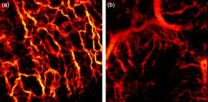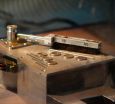(Press-News.org) Europe accounted for two thirds of the world-wide newly installed photovoltaic (PV) capacity in 2011, with 18.5 GW. Its overall PV capacity totalled 52 GW. The yearly electricity produced by PV could power a country with the electricity demand of Austria, which corresponds to 2% of the EU's electricity needs. These are some of the highlights of the 2012 Photovoltaics Status Report published today by the European Commission's Joint Research Centre.
The study summarises and evaluates the current activities regarding manufacturing, policies and market implementation world-wide.
Over the past ten years, the PV industry grew in Europe by an average of over 40% per year and the production costs have decreased by around 60%. Underlying this progress is the EU commitment towards PV systems as a means to achieve the goal of using 20% of renewable energy by 2020.
Germany, Italy, Spain, the Czech Republic, France, Belgium, and the United Kingdom are the leaders in installed PV capacity in Europe.
Since 2000, world-wide, total PV production had growth rates of between 40 and 90%. The most rapid growth in annual production over the last five years was observed in Asia, where China alone accounts for more than 50% of the world's PV production. In addition, for the second year in a row, solar power was the renewable energy that attracted most investment, with a total of 98.5 billion euros world-wide, of which two thirds were concentrated in Europe.
A challenge for the European industry in this field is China's massive investment in PV manufacturing, which has led to an economy of scale in manufacturing in that country. However, the delivery of manufacturing equipment from Europe to Asia is still beneficial as Europe still has the lead in PV research and development, thereby innovating the European PV manufacturing equipment industry.
The report highlights that PV technology and its deployment is a global business and considers that future generations of PV technologies could spring from international cooperation on eco-innovation, in partnership with Asia and the United States.
In addition, it highlights that there is a large scope for PV innovation in the achievement of both energy efficiency and improved design in buildings. PV modules can be incorporated and specifically designed as building materials, functioning as an insulation material and fostering a new "European PV-architecture", whilst at the same time providing one of the key technologies required to achieve zero emissions buildings.
###Download
2012 Photovoltaics Status Report: http://re.jrc.ec.europa.eu/refsys/
Contact
JRC press officer, elena.gonzalez-verdesoto@ec.europa.eu
Two-thirds of the world's new solar panels were installed in Europe in 2011
2012-09-24
ELSE PRESS RELEASES FROM THIS DATE:
Glacial youth therapy for the Scandinavian landscape
2012-09-24
The high elevation flat surfaces characteristic of the Norwegian landscape are in geologically terms young, according to a paper in Nature Geoscience.
In a paper recently published in Nature Geoscience, researchers from the University of Bergen (UiB) and ETH Zurich have demonstrated that ice sheets have extensively shaped the fjords of Norway for the last 2.8 million years.
– However, the massive sediment record deposited offshore Norway during this period tells us a more complex story, explains Postdoctoral Fellow Philippe Steer at UiB's Department of Earth Science ...
Fueling the fleet, Navy looks to the seas
2012-09-24
WASHINGTON--Refueling U.S. Navy vessels, at sea and underway, is a costly endeavor in terms of logistics, time, fiscal constraints and threats to national security and sailors at sea.
In Fiscal Year 2011, the U.S. Navy Military Sea Lift Command, the primary supplier of fuel and oil to the U.S. Navy fleet, delivered nearly 600 million gallons of fuel to Navy vessels underway, operating 15 fleet replenishment oilers around the globe.
From Seawater to CO2
Scientists at the U.S. Naval Research Laboratory are developing a process to extract carbon dioxide (CO2) and produce ...
Glass half full: Double-strength glass may be within reach
2012-09-24
Glass is strong enough for so much: windshields, buildings and many other things that need to handle high stress without breaking. But scientists wholook at the structure of glass strictly by the numbers believe some of the latest methods from the microelectronics and nanotechnology industry could produceglass that's about twice as strong as the best available today.
Rice University chemist Peter Wolynes is one of them. Wolynes and Rice graduate student Apiwat Wisitsorasak determined in a new study that a process called chemical vapor deposition, which is used industrially ...
Researchers demonstrate cheaper way to produce NFO thin films
2012-09-24
Researchers from North Carolina State University and the Georgia Institute of Technology have demonstrated a less-expensive way to create textured nickel ferrite (NFO) ceramic thin films, which can easily be scaled up to address manufacturing needs. NFO is a magnetic material that holds promise for microwave technologies and next-generation memory devices.
Specifically, this is the first time researchers have used a chemical deposition process to create NFO thin films that are "textured" – meaning they have an aligned crystalline structure. Arraying the crystalline structure ...
3-year, 676-child trial shows effectiveness of low-cost intervention to improve sun protection
2012-09-24
A blistering sunburn during childhood or adolescence more than doubles the adult risk of skin cancer. The accumulation of long-term sun exposure may be equally dangerous. A study from the Colorado School of Public Health and the University of Colorado Cancer Center recently published in the American Journal of Preventive Medicine shows one way to reduce this exposure: a double-blind randomized clinical trial of mailed sun protection packets led to higher frequency of sun protective behaviors including the use of long clothing, hats, shade, sunscreen, and midday sun avoidance.
"This ...
EARTH: Bakken boom and the new Wild West
2012-09-24
Alexandria, VA – Diesel-soaked clothing, 90-hour work weeks, and the constant groaning of a multimillion-dollar oil rig towering overhead: Welcome to life in Williston, N.D., home of the United States' latest oil boom. In this month's issue of EARTH Magazine, R. Tyler Powers, a young geologist thrust into the middle of the new boomtown, offers his perspective on what life is like today in the new Wild West.
Thousands of oil rigs sit atop the Bakken Formation, a Late Devonian to Early Mississippian rock formation that underlies parts of Montana, North Dakota, Saskatchewan ...
Tissues tell the tale: Non-invasive optical technique detects cancer by looking under the skin
2012-09-24
VIDEO:
This is a 2x2x2mm extracted blood vessel structure of basal cell carcinoma in vivo exhibiting a chaotic vascular pattern (left). Virtually cut volume obtained with OCT displaying the embedded blood...
Click here for more information.
WASHINGTON, Sept. 24, 2012—The trained eye of a dermatologist can identify many types of skin lesions, but human sight only goes so far. Now an international team of researchers has developed an advanced optics system to noninvasively ...
Heritability of avoidant and dependent personality disorder traits
2012-09-24
A new twin study from the Norwegian Institute of Public Health shows that the heritability of avoidant and dependent personality disorder traits might be higher than previously reported. People with avoidant personality disorder are often anxious in the company of others, while people with dependent personality disorder feel more secure.
Results from previous studies indicate that genetic factors explain about one third of the individual differences in these personality disorder traits, while the remaining variation is best explained by environmental influences. These ...
Newly discovered molecule could deliver drugs to treat diseases
2012-09-24
MANHATTAN, Kan. -- Kansas State University researchers have discovered a molecule that may be capable of delivering drugs inside the body to treat diseases.
For the first time, researchers have designed and created a membrane-bounded vesicle formed entirely of peptides -- molecules made up of amino acids, the building blocks of protein. The membrane could serve as a new drug delivery system to safely treat cancer and neurodegenerative diseases.
A study led by John Tomich, professor of biochemistry at Kansas State University, has been published in the journal PLOS ONE ...
A windshield wiper for Mars dust is developed
2012-09-24
This press release is available in Spanish.
VIDEO:
A team of researchers at Universidad Carlos III in Madrid has developed a device that works as a windshield wiper to eliminate Mars dust from the sensors on the NASA...
Click here for more information.
Leading energy scientists from the UK and China are joining forces to develop green technology that will revolutionise the way electricity ...

